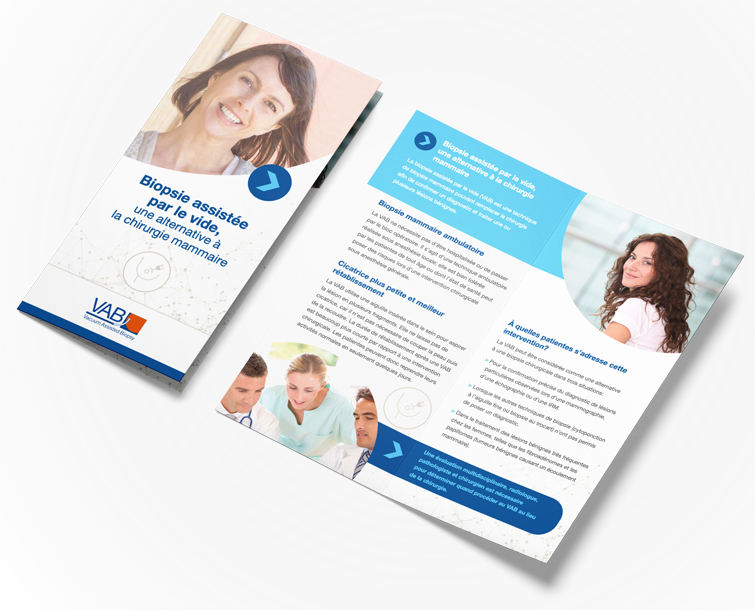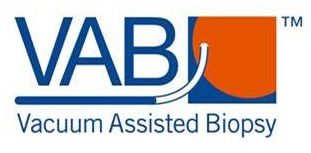Frequently asked questions
What is vacuum assisted biopsy?
Is vacuum assisted biopsy a new procedure?
VAB incorporates two new aspects:
- It can be performed with ultrasound guidance, which is more convenient than the stereotactic procedure, as the patient can lie on her back or slightly leaning to one side.
- New indications: since the beginning of the century, new alternatives to breast surgery have been developed both for diagnosis confirmation following a mammogram, an ultrasound examination, or another kind of incisional breast procedure, and for the removal of certain lesions which are not cancer.
What are the advantages of vacuum assisted biopsy
compared to surgery?
- First, it requires no hospital admission. VAB is performed as an outpatient procedure and the patient can return home afterwards.
- Second, it is done under local anaesthetics, therefore all the complications associated to general anaesthetics are eliminated and there is no need for other tests (X-rays, ECG, blood tests, etc.) and consultations to the anaesthesiologist prior to the intervention.
- Third, unlike procedures performed in the operating room, it requires no breast cuts or excisions. The biopsy needle is introduced through a small skin incision, and the lesion is “removed” through the needle so that the skin does not have to be cut nor sewn afterwards.
- Fourth, all potential complications are rarer and milder than with open breast surgery techniques.
- And last of all, although not less important, post-procedure recovery is much faster than after a surgical operation, and patients resume their normal activities after a few days.
What is the difference between vacuum assisted biopsy
and other breast biopsies where needles are used?
Breast biopsy techniques have developed considerably over the last decades. Prior to the introduction of puncture needles (fine needle aspiration or fine needle cytology, and core needle biopsy), all suspicious lesions detected in mammograms or ultrasound images were surgically resected in the operating room in order to diagnose them. If the outcome of the tests turned out to be cancer, usually, another intervention was required to complete treatment.
Fortunately, needle puncture procedures have been available for a number of years now, making it possible to confirm a diagnosis before surgery or even to avoid surgery. Nevertheless, these procedures have limitations and in some cases the removed samples or pieces are so small that a surgical biopsy has to be used to confirm the diagnosis.
The benefit of vacuum assisted biopsy (VAB) is that bigger, more numerous samples are removed, and even complete elimination of the lesion is possible. This way, uncertain outcomes are much less common, and surgical biopsies are rarely necessary. Another benefit is that, unlike what happens with the other needle puncture techniques, if a non-cancerous lesion is completely removed, the treatment can be regarded as finalized.
Is vacuum assisted biopsy painful?
Does vacuum assisted biopsy leave a scar?
Is vacuum assisted biopsy suitable for everybody?
Any person can be a candidate for vacuum assisted biopsy (VAB) regardless of their age (from teenagers to the elderly) or gender, as even though women are more likely to have breast lesions requiring biopsies, men can also need them.
Another advantage of VAB is that it can be performed in patients with conditions that could create difficulties for a surgical approach; heart or pulmonary disorders may occasionally put the patient at risk when under the effects of anaesthesia in the operating room. Patients with these conditions are considered good candidates for VAB because it is performed under local anaesthesia.
My doctor has recommended that I have a breast biopsy,
can I avoid going into surgery?
- to investigate if a lesion spotted in breast imaging is cancerous
- after fine needle aspiration or a core needle biopsy, when results are unclear
- to remove or treat a non cancerous lesion
In these three cases, vacuum assisted biopsy (VAB) may be an appropriate alternative to the surgical biopsy depending on the type of lesion. Each individual case must be assessed by the doctor recommending a biopsy and by a breast radiologist. Together, they can decide if a surgical biopsy can be avoided, and confirm the diagnosis or remove a non-cancerous lesion performing VAB as an outpatient procedure.
Is there a limitation to the size of lesion which can be removed?
How long does the procedure take?
What can I expect after the procedure?
It is possible that there is quite severe bruising visible in the breast. Don’t panic: this is normal. It will however take long, up to 8 weeks, to completely resolve.
When would vacuum assisted biopsy (VAB) or vacuum
assisted excision (VAE) not be the most appropriate option?
- For large, benign nodules, more than four or five centimeters in diameter, or nodules with hard consistency. VAB or VAE would not be indicated as it is likely that the nodules cannot be completely removed.
- In the event of large blood vessels around the lesion. These increase the probability of bleeding if they were punctured during the procedure.
- For lesions close to the skin, deep in the tissue, or underneath the nipple. These biopsies may be challenging to perform. Depending on the circumstances, VAB or VAE may be conducted by experienced specialists.
- For excision of small tumors in the ducts (papilloma) that spread inside the nipple. These cases are better treated with surgery, as there is a high probability of harming the nipple.
Even though VAE is starting to be used to treat selected cases of breast cancer, this technique is not accepted yet as a valid alternative to surgery in already diagnosed cancers. Performing either VAB or VAE must be discussed in a Multidisciplinary Breast Committee in which all the specialists responsible for diagnosis and treatment are integrated. The patient should receive clear information about the advantages and disadvantages of the different approaches in her own particular case. A consensual decision taken by the Multidisciplinary Group is also required in those specific cases where the suitability of VAB or VAE might be up for debate. Patients that show an inability to collaborate during the procedure; who are unable to stay still (especially if the procedure is guided sterotactically or with MRI); or who exhibit signs of severe anxiety are typically not good candidates for VAB/VAE. These patients should be assessed individually in order to decide the best course of action and may require sedation in order to complete the procedure.
These videos will walk you through the most common questions and answers about breast biopsy, and specifically about a Vacuum Assisted Biopsy and Vacuum Assisted Excision
What is a vacuum assisted biopsy?
Vacuum assisted biopsy aftercare
Vacuum assisted excision. What is a B3 lesion?
Get more information
Vacuum assisted biopsy, an alternative to breast surgery











BD, the BD Logo, and the VAB Logo are trademarks of Becton, Dickinson and Company or its affiliates. All other trademarks are the property of their respective owners. © 2025 BD. All rights reserved. BD-31722
